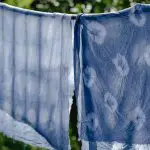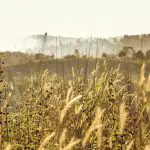When wading through the wide array of weed barrier fabrics, it's crucial to choose the best option for your garden. Different fabrics offer varying levels of durability, permeability, and longevity, making it essential to select the one that aligns with your specific needs.
Whether it's landscape fabric, plastic mulch, woven or non-woven weed barriers, or even organic options like newspaper or burlap, each has its own set of advantages and drawbacks.
Understanding the characteristics of each fabric will empower you to make an informed decision, ensuring that your garden remains weed-free and thriving.
Key Takeaways
- Landscape fabric and plastic mulch are both effective in preventing weeds, retaining water, preventing soil erosion, and promoting healthy root development.
- Plastic mulch acts as a barrier, conserves soil moisture, warms the soil, reduces the spread of soil-borne diseases, and improves fruit and vegetable quality.
- Proper installation and maintenance of plastic mulch, including preparing the soil, securely anchoring the plastic, using a drip irrigation system, and regularly inspecting for damage, are important for optimal performance.
- Consider the environmental impact of plastic mulch and opt for responsible disposal methods or use biodegradable mulch films to reduce long-term environmental harm.
Landscape Fabric
When selecting landscape fabric, consider the specific needs of your garden and the level of weed control required. The right fabric can significantly impact soil health and water retention. It acts as a protective barrier, preventing weeds from stealing essential nutrients and moisture from your soil. Plus, it reduces the need for frequent watering by aiding in water retention.
Additionally, landscape fabric plays a crucial role in erosion control and root development. It helps to prevent soil erosion by holding the ground in place, especially on slopes or areas prone to runoff. This is vital for maintaining the integrity of your garden beds. Moreover, the fabric creates an environment conducive to healthy root development, allowing plants to establish strong and stable root systems.
Plastic Mulch
Now let's talk about plastic mulch.
Plastic mulch offers a range of benefits, such as conserving soil moisture and preventing weed growth.
We'll also cover its installation and maintenance, as well as its environmental impact.
Plastic Mulch Benefits
To effectively control weeds and improve soil moisture retention, plastic mulch provides numerous benefits for gardeners and farmers. Here are some of the advantages of using plastic mulch:
- Weed suppression: Plastic mulch acts as a barrier, preventing weeds from growing and competing with your plants for nutrients.
- Moisture retention: It helps to conserve soil moisture by reducing evaporation, ensuring that your plants have a steady water supply.
- Soil warming: The mulch absorbs heat from the sun, warming the soil and promoting better root development and early plant growth.
- Disease prevention: It creates a physical barrier between the soil and plant foliage, reducing the spread of soil-borne diseases.
- Enhanced crop quality: Plastic mulch can improve the quality of fruits and vegetables by keeping them clean and preventing direct contact with the soil.
Plastic mulch offers a range of benefits that can significantly improve the health and productivity of your garden or farm.
Installation and Maintenance
The installation and maintenance of plastic mulch play a crucial role in maximizing its benefits for your garden or farm.
When installing plastic mulch, ensure the soil is well-prepared, free from large debris and weeds. Lay the plastic carefully, avoiding tears and ensuring it's securely anchored to prevent shifting. Consider using a drip irrigation system underneath the plastic for efficient water distribution.
Regularly inspect the mulch for tears or damage, and promptly repair or replace as needed to maintain its long term effectiveness. To improve the mulch's performance, consider using a layer of organic mulch on top, as it can help regulate soil temperature and reduce weed growth.
With these installation tips and proper maintenance, plastic mulch can significantly contribute to the success of your garden or farm.
Environmental Impact
Plastic mulch, when not properly managed and disposed of, can have a significant environmental impact, particularly in terms of pollution and waste accumulation in agricultural areas. To mitigate these issues, it's crucial to consider sustainability practices when using plastic mulch. Here are some key points to keep in mind:
- Proper Disposal: Dispose of used plastic mulch responsibly, following local waste management guidelines.
- Biodegradable Options: Consider using biodegradable mulch films to reduce long-term environmental impact.
- Soil Contamination: Plastic mulch debris can contaminate soils, affecting microbial activity and nutrient cycling.
- Wildlife Impact: Improperly discarded plastic mulch can harm wildlife through entanglement or ingestion.
- Longevity: Plastic mulch can persist in the environment for extended periods, contributing to waste accumulation.
Woven Weed Barrier
When it comes to weed barriers, woven fabric is a popular choice for many gardeners. It's important to understand the differences between woven and non-woven options, as well as the durability and lifespan of woven weed barriers.
Additionally, we'll explore the cost-effectiveness and maintenance considerations associated with using woven fabric for weed control.
Woven Vs. Non-Woven
You can easily distinguish woven weed barriers from non-woven ones by examining the fabric's structure. Woven weed barriers are made by weaving polypropylene strips together, creating a durable and strong fabric. On the other hand, non-woven weed barriers are made from bonded fibers, giving them a softer, more fabric-like feel.
Here are some key points to consider when comparing woven and non-woven weed barriers:
- Woven Weed Barrier:
- Pros: Highly durable and tear-resistant
- Cons: Less flexible and can be challenging to cut and install
- Non-Woven Weed Barrier:
- Pros: More flexible and easier to install
- Cons: Less durable and may break down over time
When choosing between woven and non-woven weed barriers, consider your specific needs and the expected wear and tear on the fabric.
Durability and Lifespan
To assess the durability and lifespan of a woven weed barrier, consider its resistance to tears and the expected longevity under various conditions. When comparing different materials for weed barriers, it's crucial to understand how each one holds up over time. Below is a material comparison table to help you evaluate the durability and lifespan of woven weed barriers under different conditions.
| Material | Resistance to Tears | Expected Lifespan |
|---|---|---|
| Woven Polyethylene | High | 5-7 years |
| Woven Polyester | Medium-High | 3-5 years |
| Woven Polypropylene | Medium | 2-4 years |
Understanding the durability and expected lifespan of each material will assist you in choosing the best woven weed barrier for your specific needs.
Cost-Effectiveness and Maintenance
Considering cost-effectiveness and maintenance of woven weed barriers, it's important to weigh the long-term expenses against the initial investment. When evaluating the cost-effectiveness of woven weed barriers, there are a few key points to keep in mind:
- Long Term Effectiveness: Look for weed barriers that may have a higher initial cost but offer long-term effectiveness, thus reducing the need for frequent replacements.
- Cost Saving Alternatives: Explore cost-saving alternatives that may have a slightly higher upfront cost but can save money in the long run due to their durability.
- Eco-Friendly Options: Consider eco-friendly options that not only prevent weed growth but also contribute to a healthier environment.
- Minimal Upkeep: Choose woven weed barriers that require minimal upkeep, saving you time and effort in the long run.
- Investment Perspective: View the initial cost as an investment in long-term weed control, rather than just an immediate expense.
Non-Woven Weed Barrier
The non-woven weed barrier is a popular choice for gardeners and landscapers looking for effective weed control. This type of weed barrier offers several benefits.
Non-woven fabric allows air, water, and nutrients to penetrate the soil, promoting healthy plant growth while preventing weed growth. Its permeability also reduces the need for constant watering, as it allows water to reach the soil beneath.
The fabric is durable and tear-resistant, providing long-lasting weed control and reducing the need for frequent replacements.
When it comes to installation, non-woven weed barriers are relatively easy to work with. You can simply lay the fabric over the prepared area and secure it with landscape pins or cover it with mulch. This method helps prevent weed growth while maintaining a neat and tidy appearance in your garden or landscape.
Newspaper
Using newspaper as a weed barrier involves layering sheets of paper over the soil. It's a cost-effective and eco-friendly way to suppress weeds and promote healthy soil. Here are some key points to consider when using newspaper as a weed barrier:
- Recycled materials: Newspaper is a great way to repurpose old newspapers, giving them a new life in your garden.
- Soil health: As the newspaper decomposes, it adds organic matter to the soil, improving its structure and fertility.
- Weed suppression: Newspaper effectively blocks sunlight from reaching weed seeds, preventing them from germinating and growing.
- Alternative uses: In addition to weed control, newspaper can also be used for sheet mulching, protecting plants from frost, and as a carbon-rich addition to compost.
- Biodegradability: Unlike plastic weed barriers, newspaper breaks down naturally over time, reducing waste in the environment.
Incorporating newspaper as a weed barrier is a sustainable practice that not only helps control weeds but also makes use of recycled materials in an environmentally friendly manner.
Cardboard
Layering cardboard as a weed barrier can effectively suppress weed growth and improve soil health in your garden. Cardboard benefits include its ability to smother weeds by blocking out sunlight and preventing weed seeds from germinating. It also helps retain moisture in the soil and eventually breaks down, adding organic matter to the garden bed.
When using cardboard as a weed barrier, it's important to wet it thoroughly before laying it down to prevent it from blowing away and to enhance its flexibility for conforming to the soil surface. However, keep in mind that cardboard alternatives such as landscape fabric or mulch may be better suited for certain garden areas, especially where a more polished appearance is desired. While cardboard is an excellent option for larger areas and when building new garden beds, it may not be the most visually appealing choice for all garden spaces.
Experiment with different weed barrier methods to find the best solution for your garden's specific needs.
Burlap
Consider using burlap as a weed barrier for its natural ability to suppress weed growth and enhance soil health. Burlap, made from jute fibers, is an excellent option for gardeners looking for an organic and biodegradable weed control solution.
Here are some key points to consider when using burlap as a weed barrier:
- Effectiveness: Burlap effectively suppresses weed growth by blocking sunlight and preventing weed seeds from germinating. Its thick, coarse texture also helps to smother existing weeds.
- Soil Health: Unlike plastic or synthetic weed barriers, burlap allows air and water to penetrate the soil, promoting a healthy and balanced soil ecosystem. This is crucial for the long-term health of your garden.
- Biodegradability: Burlap naturally decomposes over time, enriching the soil with organic matter. This makes it an environmentally friendly choice compared to non-biodegradable alternatives.
- Burlap Alternatives: If burlap isn't readily available, consider using other organic materials such as newspaper or cardboard as temporary weed barriers.
- Maintenance: While burlap is effective, it may require occasional replacement as it decomposes. Regular checks and replacements will ensure continuous weed suppression.
Organic Fabric Options
You can opt for using natural fabrics like burlap or hemp as effective weed barriers in your garden. When it comes to organic fabric options, there are sustainable and biodegradable materials that can serve as excellent weed barriers.
Burlap, made from jute plant fibers, is one of the most popular choices. It's biodegradable, allowing it to naturally decompose over time while still effectively suppressing weeds.
Another natural solution is hemp fabric, which is known for its durability and eco-friendly properties. Hemp is a highly sustainable option as it grows quickly, requires minimal water, and doesn't rely on pesticides or herbicides for cultivation.
By choosing these eco-friendly choices, you're not only preventing weed growth but also contributing to a more sustainable environment. Both burlap and hemp are biodegradable, meaning they won't contribute to environmental waste and can even enrich the soil as they break down.
These natural fabric options provide an effective way to control weeds in your garden while aligning with environmentally friendly practices.
Frequently Asked Questions
Can I Use Landscape Fabric or Plastic Mulch in a Vegetable Garden?
You can use landscape fabric or plastic mulch in a vegetable garden, but consider the pros and cons. Landscape fabric is more environmentally friendly, while plastic mulch retains heat and moisture. Both are viable fabric options.
Are There Any Environmental Concerns Associated With Using Woven or Non-Woven Weed Barrier Fabrics?
When using woven or non-woven weed barrier fabrics, there are environmental impacts and sustainability concerns to consider. The production, disposal, and potential leaching of chemicals from these fabrics can affect the ecosystem and soil health.
Can Newspaper or Cardboard Be Used as a Long-Term Weed Barrier in a Garden or Landscape?
For long-term weed control, both newspaper and cardboard can be effective barriers in gardens or landscapes. While newspaper decomposes faster, cardboard offers better durability. Ensure proper layering and mulching for optimal results.
Is Burlap a Suitable Option for Controlling Weeds in a Flower Bed or Garden?
Burlap has pros and cons as a weed barrier. Its effectiveness depends on the situation. It can be a suitable short-term option, but it may not have the longevity you desire for long-term weed control in a flower bed or garden.
What Are the Benefits of Using Organic Fabric Options for Weed Control?
When it comes to weed control, natural alternatives have their advantages over synthetic materials. Sustainable options reduce chemical reliance, making them a great choice for environmentally conscious gardeners looking for effective and eco-friendly solutions.
- Tetron Fabric for Marine Applications: Durability and Use Cases - June 18, 2025
- Tetron Fabric for Outdoor Furniture: Weather Resistance and Care - June 18, 2025
- Tetron Fabric for Wall Coverings: Style and Application Tips - June 18, 2025







